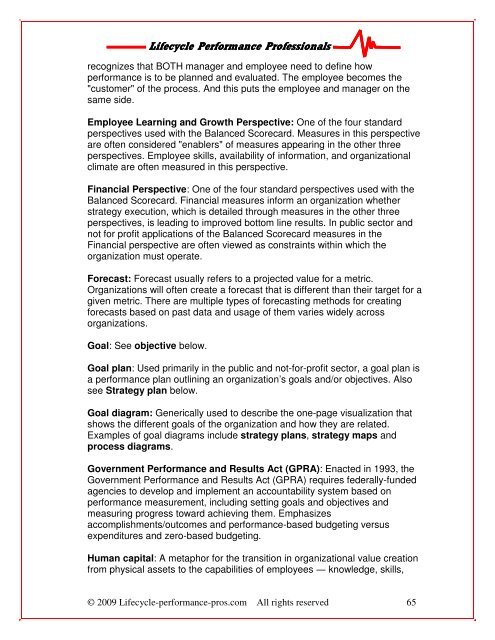Download the Performance Management Fundamentals Guide
Download the Performance Management Fundamentals Guide
Download the Performance Management Fundamentals Guide
You also want an ePaper? Increase the reach of your titles
YUMPU automatically turns print PDFs into web optimized ePapers that Google loves.
Lifecycle Lifecycle <strong>Performance</strong> <strong>Performance</strong> Professionals<br />
Professionals<br />
recognizes that BOTH manager and employee need to define how<br />
performance is to be planned and evaluated. The employee becomes <strong>the</strong><br />
"customer" of <strong>the</strong> process. And this puts <strong>the</strong> employee and manager on <strong>the</strong><br />
same side.<br />
Employee Learning and Growth Perspective: One of <strong>the</strong> four standard<br />
perspectives used with <strong>the</strong> Balanced Scorecard. Measures in this perspective<br />
are often considered "enablers" of measures appearing in <strong>the</strong> o<strong>the</strong>r three<br />
perspectives. Employee skills, availability of information, and organizational<br />
climate are often measured in this perspective.<br />
Financial Perspective: One of <strong>the</strong> four standard perspectives used with <strong>the</strong><br />
Balanced Scorecard. Financial measures inform an organization whe<strong>the</strong>r<br />
strategy execution, which is detailed through measures in <strong>the</strong> o<strong>the</strong>r three<br />
perspectives, is leading to improved bottom line results. In public sector and<br />
not for profit applications of <strong>the</strong> Balanced Scorecard measures in <strong>the</strong><br />
Financial perspective are often viewed as constraints within which <strong>the</strong><br />
organization must operate.<br />
Forecast: Forecast usually refers to a projected value for a metric.<br />
Organizations will often create a forecast that is different than <strong>the</strong>ir target for a<br />
given metric. There are multiple types of forecasting methods for creating<br />
forecasts based on past data and usage of <strong>the</strong>m varies widely across<br />
organizations.<br />
Goal: See objective below.<br />
Goal plan: Used primarily in <strong>the</strong> public and not-for-profit sector, a goal plan is<br />
a performance plan outlining an organization’s goals and/or objectives. Also<br />
see Strategy plan below.<br />
Goal diagram: Generically used to describe <strong>the</strong> one-page visualization that<br />
shows <strong>the</strong> different goals of <strong>the</strong> organization and how <strong>the</strong>y are related.<br />
Examples of goal diagrams include strategy plans, strategy maps and<br />
process diagrams.<br />
Government <strong>Performance</strong> and Results Act (GPRA): Enacted in 1993, <strong>the</strong><br />
Government <strong>Performance</strong> and Results Act (GPRA) requires federally-funded<br />
agencies to develop and implement an accountability system based on<br />
performance measurement, including setting goals and objectives and<br />
measuring progress toward achieving <strong>the</strong>m. Emphasizes<br />
accomplishments/outcomes and performance-based budgeting versus<br />
expenditures and zero-based budgeting.<br />
Human capital: A metaphor for <strong>the</strong> transition in organizational value creation<br />
from physical assets to <strong>the</strong> capabilities of employees ― knowledge, skills,<br />
© 2009 Lifecycle-performance-pros.com All rights reserved 65










